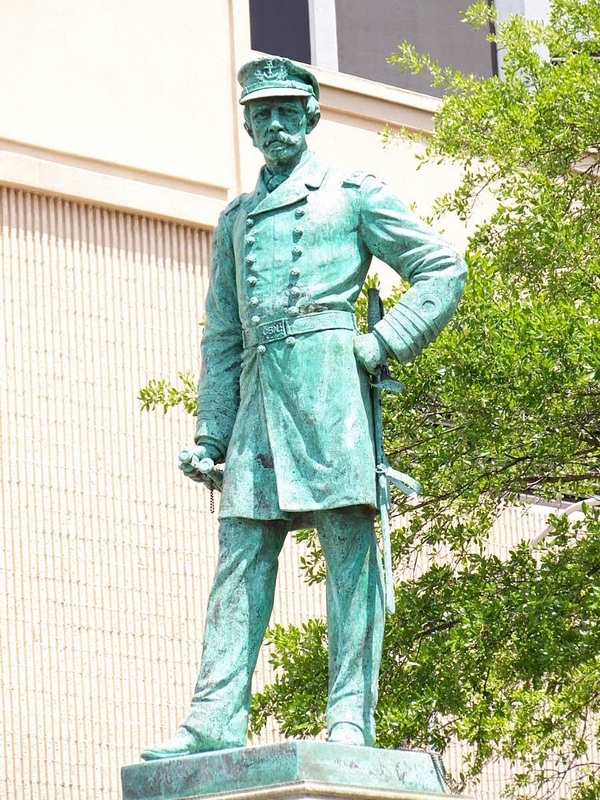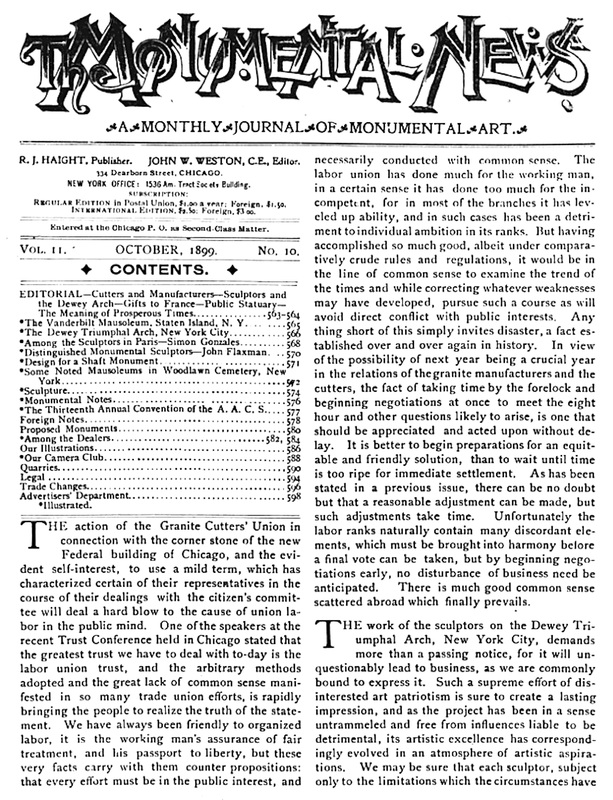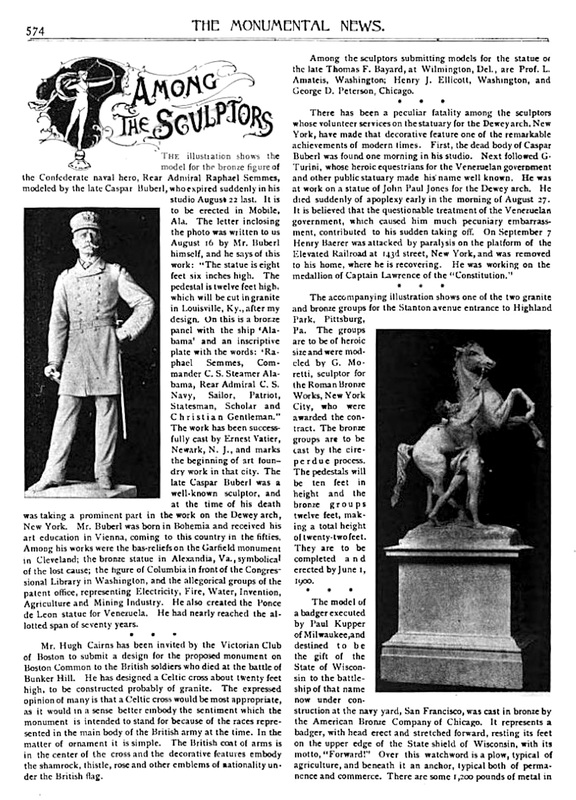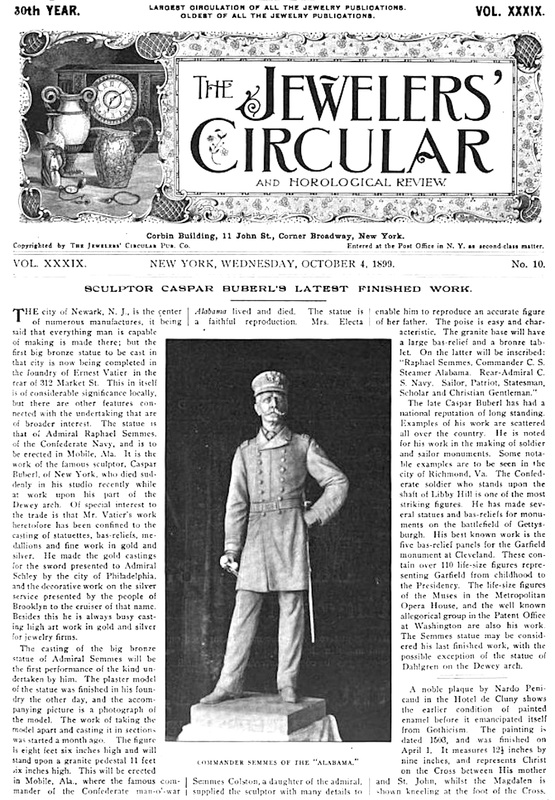ADMIRAL RAPHAEL SEMMES CAMP #11
SONS OF CONFEDERATE VETERANS
MOBILE, ALABAMA
Statue of Admiral Semmes
Formerly Overlooking
the Bankhead Tunnel in
DOwntown Mobile
Dedicated on June 27, 1900 and rededicated on June 25, 2000.
See the rededication ceremony here.
See the rededication ceremony here.
REMOVED AND STORED AT MOBILE HISTORY MUSEUM ON JUNE 19, 2020
On June 23, Commander Ringhoffer addressed the Mobile City Council. Address can be viewed below:
| semmes_statue_–_council_address_–_improved.pdf | |
| File Size: | 107 kb |
| File Type: | |
The Monumental News
VOL. 11 OCTOBER 4, 1899. No. 10.
The illustration shows the model for the bronze figure of the Confederate naval hero, Rear Admiral Raphael Semmes, modeled by the late Caspar Buberl, who expired suddenly in his studio August 22 last. It is to be erected in Mobile, Ala. The letter inclosing the photo was written to us August 16 by Mr. Buberl himself, and he says of this work: “The statue is eight feet six inches high. The pedestal is twelve feet high, which will be cut in granite in Louisville, Ky., after my design. On this is a bronze panel with the ship ‘Alabama' and an inscriptive plate with the words: ‘Raphael Semmes, Commander C. S. Steamer Alabama, Rear Admiral C. S. Navy, Sailor, Patriot, Statesman, Scholar and Christian Gentleman." The work has been successfully cast by Ernest Vatier, Newark, N. 1., and marks the beginning of art foundry work in that city. The late Caspar Buberl was a well-known sculptor, and at the time of his death was taking a prominent part in the work on the Dewey arch, New York. Mr. Buberl was born in Bohemia and received his art education in Vienna, coming to this country in the fifties. Among his works were the bas-reliefs on the Garfield monument in Cleveland; the bronze statue in Alexandria, Va., symbolical of the lost cause; the figure of Columbia in front of the Congressional Library in Washington, and the allegorical groups of the patent office, representing Electricity, Fire, Water, Invention, Agriculture and Mining Industry. He also created the Ponce de Leon statue for Venezuela. He had nearly reached the allotted span of seventy years.
Jeweler's Circular
VOL. XXXIX.
NEW YORK, WEDNESDAY,
OCTOBER 4, 1899. No. 10.
SCULPTOR CASPAR BUBERL'S LATEST FINISHED WORK
The city of Newark, N. J., is the center of numerous manufactures, it being said that everything man is capable of making is made there; but the first big bronze statue to be cast in that city is now being completed in the foundry of Ernest Vatier in the rear of 312 Market St. This in itself is of considerable significance locally, but there are other features connected with the undertaking that are of broader interest. The statue is that of Admiral Raphael Semmes, of the Confederate Navy, and is to be erected in Mobile, Ala. It is the work of the famous sculptor, Caspar Buberl, of New York, who died suddenly in his studio recently while at work upon his part of the Dewey arch. Of special interest to
the trade is that Mr. Vatier's work heretofore has been confined to the casting of statuettes, bas-reliefs, medallions and fine work in gold and silver. He made the gold castings for the sword presented to Admiral Schley by the city of Philadelphia, and the decorative work on the silver service presented by the people of Brooklyn to the cruiser of that name. Besides this he is always busy casting high art work in gold and silver for jewelry firms.
The casting of the big bronze statue of Admiral Semmes will be the first performance of the kind undertaken by him. The plaster model of the statue was finished in his foundry the other day, and the accompanying picture is a photograph of the model. The work of taking the model apart and casting it in sections was started a month ago. The figure is eight feet six inches high and will stand upon a granite pedestal 11 feet six inches high. This will be erected in Mobile, Ala., where the famous commander of the Confederate man-o’-war Alabama lived and died, a faithful reproduction. The statue is a faithful reproduction. Mrs. Electra Semmes Colston, a daughter of the admiral, supplied the sculptor with many details to enable him to reproduce an accurate figure of her father. The poise is easy and characteristic. The granite base will have a large bas-relief and a bronze tablet. On the latter will be inscribed: "Raphael Semmes, Commander C. S. Steamer Alabama. Rear-Admiral C. S. Navy. Sailor, Patriot, Statesman, Scholar and Christian Gentleman."
The late Caspar Buberl has had a national reputation of long standing. Examples of his work arc scattered all over the country. He is noted for his work in the making of soldier and sailor monuments. Some notable examples are to be seen in the city of Richmond, Va. The Confederate soldier who stands upon the shaft of Libby Hill is one of the most striking figures. He has made several statues and bas-reliefs for monuments on the battlefield of Gettysburgh. His best known work is the five bas-relief panels for the Garfield monument at Cleveland. These contain over 110 life-size figures representing Garfield from childhood to the Presidency. The life-size figures of the Muses in the Metropolitan Opera House, and the well known allegorical group in the Patent Office at Washington are also his work. The Semmes statue may be considered his last finished work, with the possible exception of the statue of Dahlgren on the Dewey arch
The city of Newark, N. J., is the center of numerous manufactures, it being said that everything man is capable of making is made there; but the first big bronze statue to be cast in that city is now being completed in the foundry of Ernest Vatier in the rear of 312 Market St. This in itself is of considerable significance locally, but there are other features connected with the undertaking that are of broader interest. The statue is that of Admiral Raphael Semmes, of the Confederate Navy, and is to be erected in Mobile, Ala. It is the work of the famous sculptor, Caspar Buberl, of New York, who died suddenly in his studio recently while at work upon his part of the Dewey arch. Of special interest to
the trade is that Mr. Vatier's work heretofore has been confined to the casting of statuettes, bas-reliefs, medallions and fine work in gold and silver. He made the gold castings for the sword presented to Admiral Schley by the city of Philadelphia, and the decorative work on the silver service presented by the people of Brooklyn to the cruiser of that name. Besides this he is always busy casting high art work in gold and silver for jewelry firms.
The casting of the big bronze statue of Admiral Semmes will be the first performance of the kind undertaken by him. The plaster model of the statue was finished in his foundry the other day, and the accompanying picture is a photograph of the model. The work of taking the model apart and casting it in sections was started a month ago. The figure is eight feet six inches high and will stand upon a granite pedestal 11 feet six inches high. This will be erected in Mobile, Ala., where the famous commander of the Confederate man-o’-war Alabama lived and died, a faithful reproduction. The statue is a faithful reproduction. Mrs. Electra Semmes Colston, a daughter of the admiral, supplied the sculptor with many details to enable him to reproduce an accurate figure of her father. The poise is easy and characteristic. The granite base will have a large bas-relief and a bronze tablet. On the latter will be inscribed: "Raphael Semmes, Commander C. S. Steamer Alabama. Rear-Admiral C. S. Navy. Sailor, Patriot, Statesman, Scholar and Christian Gentleman."
The late Caspar Buberl has had a national reputation of long standing. Examples of his work arc scattered all over the country. He is noted for his work in the making of soldier and sailor monuments. Some notable examples are to be seen in the city of Richmond, Va. The Confederate soldier who stands upon the shaft of Libby Hill is one of the most striking figures. He has made several statues and bas-reliefs for monuments on the battlefield of Gettysburgh. His best known work is the five bas-relief panels for the Garfield monument at Cleveland. These contain over 110 life-size figures representing Garfield from childhood to the Presidency. The life-size figures of the Muses in the Metropolitan Opera House, and the well known allegorical group in the Patent Office at Washington are also his work. The Semmes statue may be considered his last finished work, with the possible exception of the statue of Dahlgren on the Dewey arch



